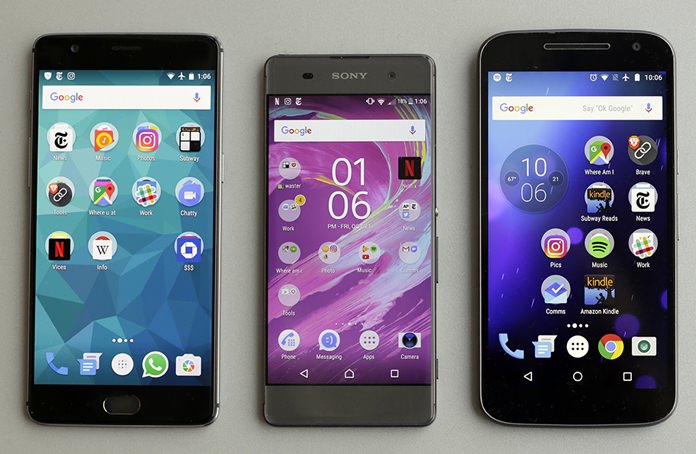New York (AP) – You can easily save hundreds of dollars on an Android phone – especially if you, like many people, don’t need a top-end camera.

Cheaper Android phones are, in many respects, adequate substitutes for pricier high-end models such as Samsung’s Galaxy S7 and Google’s Pixel. There are dozens worthy of consideration. I’m recommending three out of the handful I’ve tested: the OnePlus 3, Sony’s Xperia XA and Motorola’s Moto G4. All three are easy to use and have great battery life, enough for four or five movies on Netflix.
The drawbacks? For one, availability. Of the three phones, only the Moto is compatible with all the major U.S. carriers. And then there’s the camera. All smartphones take decent shots in good conditions, but high-end phones typically do better in the dark. I’ll trade hundreds of dollars in savings for a camera that does well most of the time, but shutterbugs might seek perfection.
OnePlus 3 ($399)
What’s Good: You’re not sacrificing the speed or power of top-end models. The OnePlus also has a fine camera – I could tell, even as a photography dummy. To combat blurry shots, especially in low light, the OnePlus has an anti-shake technology that’s rare for mid-range phones. Even selfies taken at dusk turned out well. The camera’s interface is nice, too, letting you swipe up or down to change from video to photo mode. OnePlus also has bells and whistles like a fingerprint scanner to unlock phones and a wireless chip for making payments in retail stores using Android Pay. It ran Netflix the longest among the three phones tested.
What’s Bad: The 5.5-inch screen is great for watching video but makes the phone too big to use comfortably one-handed. That’s a matter of personal preference, of course. Taking a screenshot is awkward, requiring the power and volume key to be pressed simultaneously, which is harder than it sounds. This is standard Android, but a few other manufacturers have found ways to tweak this. Folder icons don’t show you what apps are inside, making navigation difficult if you forget where you put your apps (again, standard Android). The phone’s not water-resistant.
Down The Road: You can’t add storage, but it comes with a fairly generous 64 gigabytes. And you don’t have as much flexibility to change carriers, as it’s not compatible with Verizon or Sprint.
Sony Xperia XA ($279)
What’s Good: Aesthetics-wise, this light, sleek phone is my favorite. It is easy to hold and use this 5-inch phone with one hand. Taking a screenshot is simple – hold down the power key, tap the screenshot option. Folders sport mini-icons of the apps they contain. You can set an alarm clock with a few taps from the home screen. The phone supports Android Pay, too.
What’s Bad: Its battery is the weakest of the bunch, in part because the phone’s smaller than the others. At default settings, the phone’s display is so dark that I sometimes had to squint to look at it. It’s better once I turned off “adaptive brightness” in the settings. Photos taken in a dimly lit room didn’t turn out well. Although one swipe switches the camera from photo to video mode or from selfie to outward-facing shots, it wasn’t intuitive and took a few hours to notice. There’s also an annoying lag when switching between the modes. The Xperia lacks a fingerprint scanner and isn’t water-resistant, unlike Sony’s top-end models.
Down The Road: You can add a MicroSD card for more storage beyond the stingy 16 gigabytes offered. As with the OnePlus, it won’t work with Verizon or Sprint.
Moto G (starts at $200)
What’s Good: The phone has a textured plastic back, so it doesn’t feel as slippery. You can customize the phone’s look when you order it with different color combinations. The camera was fine, although not as good as that on the OnePlus. There’s easy access to an alarm clock on the home screen. A swipe to the right brings up your calendar, weather and news stories linked to the Google Now digital assistant; although this is standard Android, it’s missing on the other two phones. For $50 more, you can get a Plus version with a more powerful camera and a fingerprint reader (I tested the regular model).
What’s Bad: It is bulkier than the other phones and looks cheaper. Like the OnePlus, you need two hands for the 5.5-inch phone. Taking a screenshot is difficult, and folders don’t show the apps inside. There’s no Android Pay. Oddly, there’s also no indicator light that comes on when the phone is charging. You can flick your wrist to switch from selfie to regular camera mode, but I found this difficult to do. Getting from photo to video mode takes two taps. Though Motorola says the phone will resist spills and light rain, you can’t submerge it in water.
Down the Road: The regular G4 and Plus version both start with 16 gigabytes of storage, again stingy these days, but you can pay for more up front or add storage later with a MicroSD card. And hallelujah, it’s compatible with all major U.S. cellular networks.




